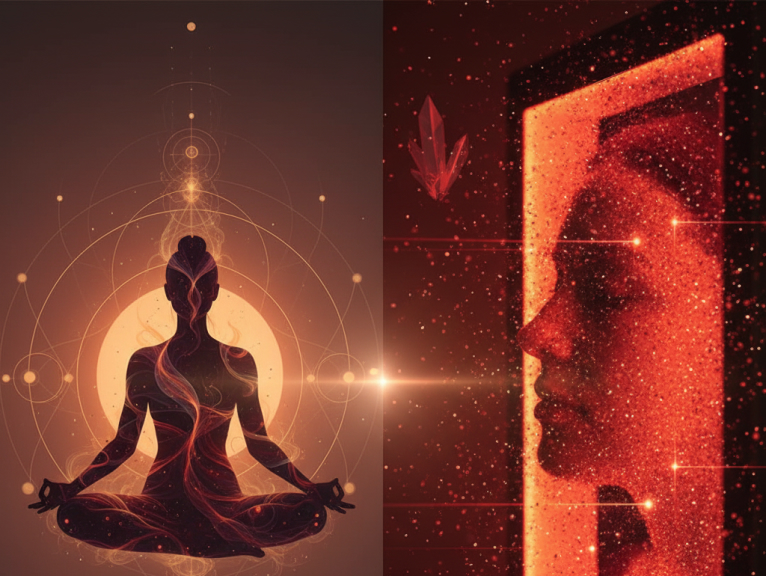
20 Years of Producing the Highest Quality, Most Reliable, and Effective LED mask.
Discover how yoga, meditation, and red light therapy work together to boost energy, reduce stress, and support full-body regeneration—backed by science

In today’s fast-paced world, fatigue, stress, and low energy levels have become common experiences. During the darker winter months, these feelings are often amplified. Many people notice sluggishness, disrupted sleep, and even seasonal mood swings when natural light becomes scarce. According to the NHS, Seasonal Affective Disorder (SAD) is directly linked to reduced exposure to sunlight, which disrupts the body’s natural circadian rhythms.
But the good news is that our bodies are highly adaptable. By combining three simple yet powerful practices—yoga, meditation, and light therapy—we can restore balance, improve energy, and support physical and mental regeneration. This article dives deep into the science behind these practices, how they work individually, and how you can integrate them into a single routine for maximum benefit.
Light is one of the most powerful external factors influencing our health. It plays a critical role in regulating hormones such as melatonin (which affects sleep) and serotonin (which impacts mood). When light is scarce, our circadian rhythms—our internal “biological clocks”—become disrupted.
Research from Harvard Health shows that different wavelengths of light affect the body in different ways. Blue light, for example, suppresses melatonin and keeps us alert, which is useful in the morning but disruptive if used at night. Red and near-infrared light, on the other hand, penetrate deeper into the body and influence cellular repair processes.
Studies also show that light therapy can reset circadian rhythms and improve symptoms of seasonal depression (NIH circadian rhythm research). Red and near-infrared wavelengths in particular stimulate mitochondria—the “powerhouses” of our cells—enhancing ATP production and reducing oxidative stress (photobiomodulation study).
When combined with yoga and meditation, light therapy not only boosts mood and sleep but also enhances the body’s ability to heal and regenerate.
Yoga has been practiced for thousands of years as a way to unite body and mind through movement, breath, and mindfulness. Today, it’s backed by modern science as an effective way to reduce stress, improve flexibility, and support cardiovascular health.
A 2019 PubMed study on yoga and stress reduction showed significant reductions in anxiety and improved mood after consistent practice.
Meditation is the practice of training the mind to focus and redirect thoughts. It reduces stress, increases awareness, and enhances emotional stability.
The NIH notes that mindfulness meditation has been shown to improve sleep, reduce anxiety, and support overall well-being.
Even just 5 minutes per day can deliver noticeable benefits. Apps such as Headspace or Calm provide guided sessions for beginners.
Among all wellness practices, red and near-infrared light therapy (RLT) has gained attention for its ability to stimulate healing at the cellular level.
Red and near-infrared light penetrate skin and muscle tissues, where they are absorbed by mitochondria. This process:
Modern LED light therapy devices make it possible to use RLT safely at home. You can also compare devices with the panel comparison tool to find the best option for your needs.
By combining yoga, meditation, and light therapy, you create a holistic practice that nourishes body, mind, and cells.
1. What is the best time of day for light therapy?
Morning is best, as it helps reset circadian rhythms and boost energy.
2. Can light therapy improve sleep?
Yes. By supporting melatonin regulation, RLT can improve sleep quality.
3. How long before I see results?
Most people notice benefits within 2–4 weeks of consistent practice.
4. Can I combine yoga and meditation during light therapy?
Yes. Many people meditate while receiving RLT, creating a calming, multitasking practice.
5. Is red light therapy safe for the skin?
Yes. Studies show it stimulates collagen without UV damage.
6. Can RLT help with depression or SAD?
It can support mood by regulating circadian rhythms, though medical treatment may also be necessary.
7. How does red light compare with blue light?
Blue light boosts alertness but can disrupt sleep if used late. Red light supports healing and circadian balance.
8. Is there a risk of overuse?
Sessions of 5–20 minutes are safe. Overuse doesn’t usually cause harm, but more is not always better.
9. Can athletes benefit from RLT?
Yes. Studies confirm faster recovery, reduced inflammation, and improved endurance.
10. How do I choose the right device?
Use a device comparison tool to evaluate size, power, and wavelength.
By combining yoga, meditation, and red light therapy, you create a holistic routine that supports physical vitality, emotional stability, and cellular regeneration. In just 15–20 minutes a day, you can improve sleep, reduce stress, and restore energy—even during the darkest months of the year.
To continue your journey:
